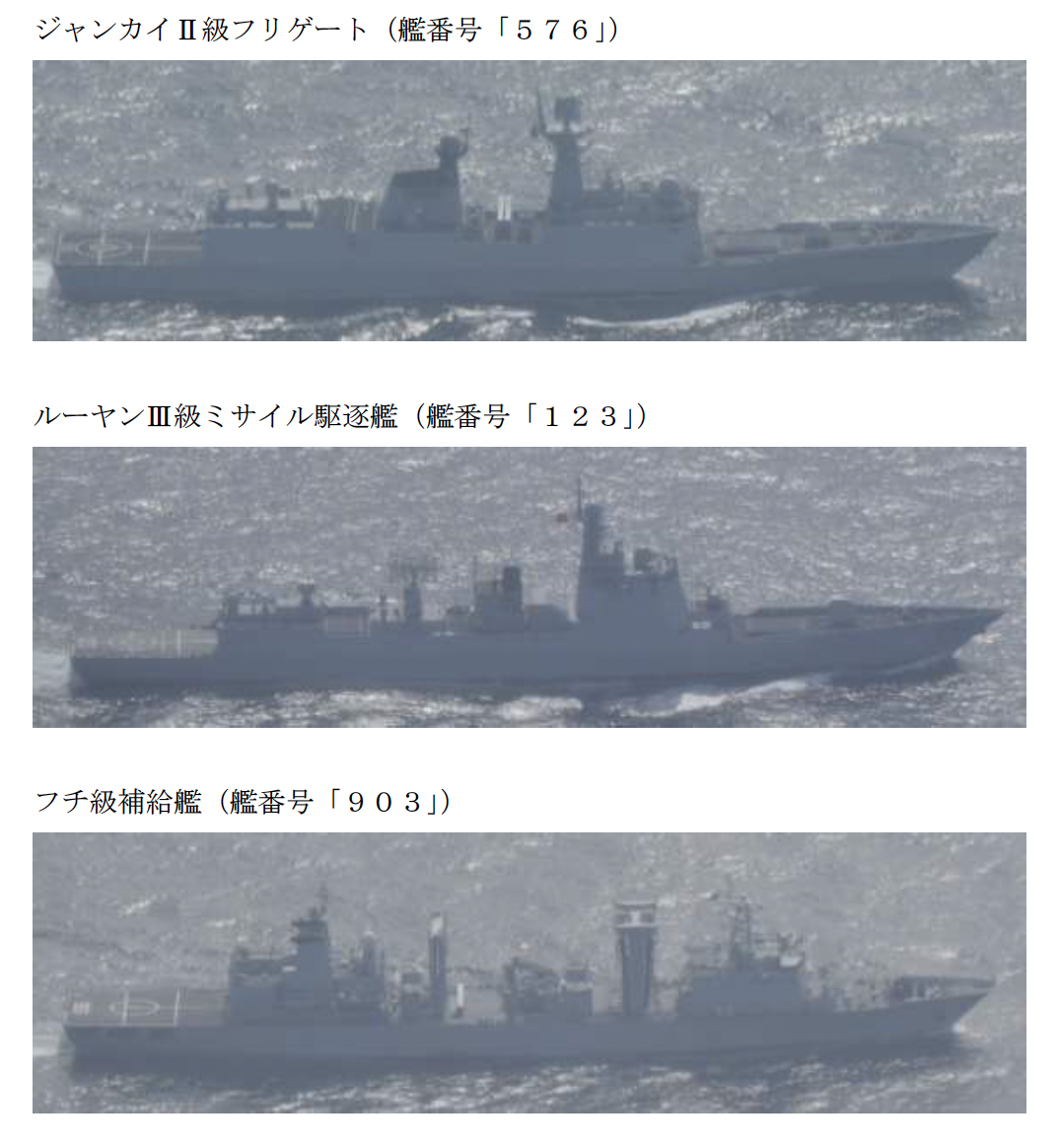
People’s Liberation Army Navy (PLAN) ships have been sailing through the waters between Taiwan and Japan over the past week, along with Chinese surveillance aircraft and an unmanned aerial vehicle flying near Japan, according to Japan’s Joint Staff Office (JSO). A Russian surveillance ship has been sailing off the coast of Japan during the same period, the JSO also reported.
From Mar. 25 to Mar. 27, PLAN destroyer CNS Changchun (150) and frigate CNS Changzhou (549) cruised around in an area 93 miles south of Miyako Island to 105 miles south of Ishigaki Island, according to a Thursday JSO release. Subsequently, from Mar. 27 to Mar. 28, the PLAN ships sailed north between Yonaguni Island and Taiwan, according to the release, before sailing farther north in an area 50 miles west of Uotsuri Island – one of the disputed Senkaku Islands held by Japan, and claimed by China and Taiwan.
The PLAN ships, on Mar. 23, had sailed northeast between the islands of Amani Oshima and Yokoate to enter the Pacific Ocean, according to the release. Japan Maritime Self-Defense Force destroyer escort JS Tone (DE-234), along with JMSDF P-1 maritime patrol aircrafts (MPA) of Fleet Air Wing 1 based at JMSDF Kanoya Air Base on the main island of Kyushu and JMSDF P-3C Orion MPAs of Fleet Air Wing 5 station at Naha Air Base, Okinawa, shadowed the PLAN ships.
On Mar. 25, PLAN Shupang-class hydrographic survey ship Mao Yisheng (29) was sighted sailing northeast at midnight in an area 25 miles south of Yonaguni Island, according to a JSO release. The survey ship subsequently sailed northeast in the waters between Yonaguni Island and Iriomote Island and was later sighted sailing northwest in an area 50 miles west of Uotsuri Island. Tone and a P-3C Orion MPA of Fleet Air Wing 5 conducted surveillance on Mao Yisheng, according to the release.
On Wednesday, the JSO issued a release saying that from the morning and afternoon of that day, Chinese Y-9 electronic intelligence (ELINT) aircraft flew in from the East China Sea and then flew through the Miyako Strait between Okinawa and Miyako Island. The Y-9 subsequently flew south of the Sakishima Islands archipelago before turning back and transiting the Miyako Strait to enter the East China Sea, according to the release. In response, Japan Air Self-Defense Force (JASDF) scrambled fighter aircraft of the Southwestern Air Defense Force.
A Y-9 flew in that day from the East China Sea and then transited through the Miyako Strait and flew to a point west of Okinawa, before turning back and transiting the Miyako Strait to return to the East China Sea in the afternoon, according to a Monday JSO release. JASDF fighter aircraft of the Southwestern Air Defense Force were scrambled in response, according to the release.
On Mar. 26, the JSO issued a release saying that on the morning of that day, a Chinese WZ-7 unmanned air vehicle flew in from the continent and circled over the Sea of Japan before turning northwest, returning to the continent. JASDF fighter aircraft were scrambled in response, according to the release.
At 2 p.m. Sunday, according to the JSO, PLAN destroyer CNS Huainan (123), frigate CNS Daqing (576) and fleet oiler CNS Kekexilihu (903) were sighted sailing southwest 31 miles northeast of Tsushima and subsequently sailed southwest through the Tsushima Strait to enter the East China Sea. From Mar. 16-Mar.1 7, the PLAN ships transited northeast through the strait to enter the Sea of Japan, according to the release. Fast attack craft JS Otaka (PG-826) and a JMSDF P-1 MPA of Fleet Air Wing 4 based at Naval Air Facility Atsugi, Honshu, shadowed the PLAN ships, according to the release.
Meanwhile, Russian intelligence ship Kareliya (535) has been sailing off the coast of Japan, according to JSO releases. At 1 a.m. Mar. 24, the Russian ship was sighted sailing south 31 miles west of the island of Oshakujima and subsequently sailed from the contiguous zone of that island to the contiguous zone of Sado Island, before exiting the contiguous zone in an area off the north of the Noto Peninsula and then sailed west, according to the JSO.
A contiguous zone is a band of water up to 12 miles from territorial waters in which states have limited jurisdiction to prevent or punish infringement of its customs, fiscal, immigration or sanitary laws and regulations. As such, the passage of the Russian ship was within international law. Fast-attack craft JS Hayabusa (PG-824) and a JMSDF P-1 MPA of Fleet Air Wing 2 based at JMSDF Hachinohe Air Base, Honshu, shadowed Kareliya, according to the release.
A second release on Thursday said that on Wednesday at 10 a.m., the Russian ship was sighted sailing southwest in an area 56 miles northwest of Tsushima, and from Wednesday to Thursday, Kareliya transited the Tsushima Strait to enter the East China Sea. Fast-attack craft Otaka and JMSDF P-1 MPAs of Fleet Air Wing 1 and Fleet Air Wing 4 shadowed the Russian intelligence ship, according to the release.
On Monday, the JSO issued the latest update Kareliya’s movements, saying that on Saturday at 6 a.m., the Russian intelligence ship was sighted sailing southeast in an area 25 miles west of Kume Island and subsequently transited the Miyako Strait to enter the Philippine Sea. On Monday, Kareliya transited the Miyako Strait, sailing west to return to the East China Sea. Minesweeper JS Awaji (MSO-304), fleet oiler JS Oumi (AOE-426) and JMSDF P-3C Orion MPAs of Fleet Air Wing 5 conducted surveillance on the ship, according to the release.





